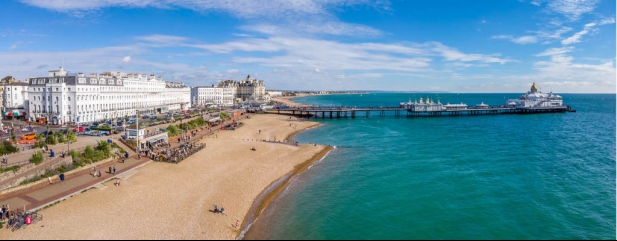Archived article
Please note that tax, investment, pension and ISA rules can change and the information and any views contained in this article may now be inaccurate.
Looking to boost a pension pot and buy a boat with house sale proceeds

This is the latest part in a regular series in which we will provide an investment clinic based on hypothetical scenarios. By doing so we aim to provide some insights which can help different types of investor from beginners all the way up to experienced market participants.
Having sold her house in Stroud for £375,000, 55-year-old Glenda has downsized to a smaller property by the sea in Eastbourne. The property set her back £300,000 and is where she intends to stay put.

With decades working in the automotive sector Glenda has wasted no time in securing a job for a company that restores old cars and hopes she’ll be able to keep working for the next 10 years. She has £40,000 left from the house sale, after accounting for various bits and bobs such as estate agent fees, removal costs and cash she has set aside to fix up her new abode.
Hard-working Glenda has 30 years’ worth of National Insurance contributions under her belt and hopes she will have enough to get the full state pension by the time she hits retirement age. That money will help pay the bills, but it won’t be anywhere near enough to fund her desired lifestyle.
Glenda loves sailing and would like to buy her own boat, albeit an affordable one rather than a super yacht. She has £5,000 on a credit card with an interest rate of 18% and a £4,000 personal loan with a 6% interest rate left to pay over the next four years. She admits to being more of a spender than a saver, yet Glenda realises that in the next 10 years the money left from her house sale could be used to build up a bigger retirement pot.
WHAT SHOULD GLENDA DO?
The first thing Glenda needs to consider is curbing her spending and focusing on paying off her expensive debt; after all it would be very difficult for her to find an investment which offered a return which could match the interest she is paying off on her credit card debt in particular.
She could download a money app, which would be helpful in terms of creating a plan and a budget that she can stick to.
Glenda has amassed a pension pot worth £30,000, which is relatively small but provides a solid base from which to build up her retirement savings by staying invested in the market for the next decade. She intends to draw down on her pension pot when she eventually retires, rather than purchase an annuity (a guaranteed income for life) which at current rates would offer a pretty limited income.
At a still-sprightly age, Glenda has at least another decade of work ahead of her. This means she has time to put money to work in, and ride the ups and downs of, the equity market.
Targeting an annual return of 6%, Glenda is happy to take on some risk, although high-octane assets like individual resources stocks, small cap equities or cryptocurrencies such as bitcoin aren’t for Glenda at this stage of her life.
Given her risk appetite, she might consider investing in a diversified mid cap fund such as AXA Framlington UK Mid Cap (B3SYV56) or a FTSE 250-focused investment trust, such as JPMorgan Mid Cap (JMF) or Schroder UK Mid Cap (SCP).
Typically growing their sales and profits at a faster rate than large cap companies, mid caps are also more established businesses than small cap firms, which generally speaking means they are less risky.
Mid caps could provide Glenda with an attractive combination of growth with an income stream she can reinvest, thereby benefiting from compound return. She might also look to purchase an ETF (exchange traded fund) such as iShares Core MSCI World (SWDA).
These passive vehicles typically have lower costs than active funds and will allow Glenda to keep a greater portion of her investment returns while achieving diversified exposure to the markets.
As Glenda knows the car industry inside out, she might consider having an individual investment in a robustly-financed dealership; examples listed on the London Stock Exchange include Marshall Motor (MMH:AIM), Vertu Motors (VTU:AIM) and second hand car specialist Motorpoint (MOTR).
We are sailing

Once she has paid down her expensive debt, Glenda can look to realise her boat ownership goal. In the dream scenario she would buy a second hand sailing boat of 22-26 foot, which would set her back between £4,000 and £5,000, and moor the boat at Eastbourne Harbour, which costs £2,500 per year. She’ll also need to factor in servicing costs on top as she will need an engine to get in and out of the marina.
A more realistic alternative would be to look at a smaller boat such as a ‘Topper’ or ‘Laser’, then joining a local sailing club would be a
great idea.
This option would give Glenda access to helping hands if she encounters any problems with her boat, and to a vibrant social scene with lots of barbecues on the beach, UK weather permitting. The cost of a local sailing club is £115 per year for membership and then £200 per year for boat storage. A Laser costs around £500 for a second-hand one, versus £3,000 or more for a new boat.
DISCLAIMER. This article is based on a fictional situation to provide an example of how someone might approach investing. It is not a personal recommendation. It is important to do your research and understand the risks before investing.
Important information:
These articles are provided by Shares magazine which is published by AJ Bell Media, a part of AJ Bell. Shares is not written by AJ Bell.
Shares is provided for your general information and use and is not a personal recommendation to invest. It is not intended to be relied upon by you in making or not making any investment decisions. The investments referred to in these articles will not be suitable for all investors. If in doubt please seek appropriate independent financial advice.
Investors acting on the information in these articles do so at their own risk and AJ Bell Media and its staff do not accept liability for losses suffered by investors as a result of their investment decisions.

 magazine
magazine








